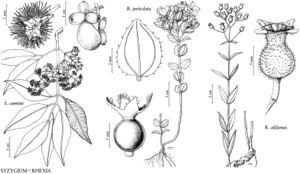Rhexia petiolata
Fl. Carol., 130. 1788.
Caudices developed; roots short, fibrous, lignescent, non-tuberiferous. Stems unbranched or few-branched, 10–50 cm, faces subequal, flat to convex, angles weakly ridged, internodes glabrous, nodes sparsely hirsute, hairs eglandular. Leaves: petiole 0.5–1.5 mm; blade ovate to short-elliptic or suborbiculate, 1–2 cm × 4–14 mm, margins serrate, surfaces glabrous abaxially, sparsely villous adaxially. Inflorescences condensed, mostly obscured by foliaceous bracts. Flowers: hypanthium globose, much longer than the constricted neck, 5–7(–9) mm, mostly glabrous except along calyx lobes; calyx lobes oblong-lanceolate, apices acute, spreading-ciliate, eglandular; petals ascending to divergent, lavender-rose, 1–2 cm; anthers straight, 1.2–1.8 mm. Seeds 0.6 mm, surfaces pebbled or with ridges of domelike processes. 2n = 22.
Phenology: Flowering Jun–Sep.
Habitat: Wet pine flatwoods and savannas, pine-cypress flats, cypress-pine-gum flats, cabbage palm hummocks, hillside bogs, swales, swamp and pocosin borders, borrow pits, ditches, roadsides, disturbed sites, sandy peat.
Elevation: 0–50 m.
Distribution
Ala., Fla., Ga., La., Md., Miss., N.C., S.C., Tex., Va.
Discussion
Selected References
None.
